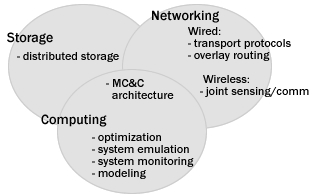Distributing
The distributed computing and communication infrastructure provides the underlying computational architecture that links, operates, and coordinates the whole DCAS system and all its networks. The Distributing Research Thrust is concerned with such key functions as data movement, data storage, archival processing, and optimizing how all the system resources are dynamically employed to meet end user data needs.
The Distributing Thrust focused on several critical issues:
- To develop the end user and application-driven adaptive resource allocation and optimization algorithms for DCAS systems that include hazardous wind environments and rain.
- To develop an integrative, distributed system sense-and-response software architecture that can meet the adaptivity and timeliness requirements dictated by end user needs, and the intrinsic properties of the environment being sensed. Key components of this architecture include computing, networking, and storage.
- To develop the architecture and protocols for remote-sensing networks in resource-poor environments.
 In order to meet these goals, we undertook a broad set of research projects, ranging from near-term to long-term and from applied development to theoretical analyses and modeling in the sub-disciplines of computing, networking, and storage. Several of our projects lay at the intersection of two or more of these sub-disciplines, as shown in this diagram. In order to meet these goals, we undertook a broad set of research projects, ranging from near-term to long-term and from applied development to theoretical analyses and modeling in the sub-disciplines of computing, networking, and storage. Several of our projects lay at the intersection of two or more of these sub-disciplines, as shown in this diagram.
Overall Software System Architecture
The Meteorological Command and Control (MC&C) performs the system's main control loop - ingesting data from remote radars, identifying meteorological features in this data, making features available for presentation to end users, and optimizing the configuration of each radar's future scan strategy based on detected features and end user requirements. We have "closed the loop" with a live MC&C controlling the Massachusetts Test Bed radar, and benchmarked the MC&C component performance. Using the DCAS emulator, we have also benchmarked performance in an emulated 4-node CASA DCAS network, demonstrating the ability of the software system architecture and the provisioned computing infrastructure to meet IP1's computational and timing requirements.
Optimizing the Use of Radar Resource
The goals of this project were to optimize the targeting of a set of overlapping and collaborating radars to direct their scanning when and where end user needs are greatest. CASA researchers from the End User, Sensing, Distributing, and Predicting thrusts have jointly refind the utility function that characterizes the value of a particular sector scan to the end-to-end system. Using the DCAS emulator, we performed a performance evaluation of sit-and-spin versus targeted-sector scanning, obtaining results illustrating the higher utility gained by adaptive sector-scanning over sit-and-spin. We initiated projects on optimal wind field retrieval and on a comparison of myopic versus multi-time-step optimization, with promising results.
|